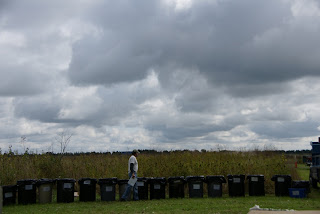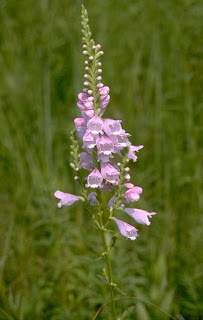Friday, November 6, 2009
Radio Talk
Julie's Summer Report
- I began working on a new plant map to illustrate and provide information, including the GPS locations of plants that we gathered throughout the summer. The map will include a picture and a link to an informative website. So far, this map includes mostly the locations of the lilies, along with 10 other species.
Friday, October 30, 2009
Tomorrow's (10/31) Harvest Cancelled
Unfortunately, the harvest for tomorrow, October 31 is cancelled. It is just too wet and sloppy and would be too much of a mess tomorrow, even if the sun does come out. Thank you very much if you were planning on attending, and please pass the word on that the harvest is cancelled.
Thursday, October 15, 2009
Harvest Photos
Thursday, October 1, 2009
In Case of Rain
Looking for Volunteers
Wednesday, September 23, 2009
Species of the Prairie Harvest
Monday, September 21, 2009
Press Coverage: Baltimore Checkerspot Release
Friday, September 18, 2009
Volunteer Fair
Friday, September 11, 2009
Of plants old and new
I am here working on the notoriously difficult grass-like plants known as the Sedges and Rushes. In the Spring of 2009, Bob Lootens and I visited Dr. Betz' wife. It was in their home that she presented to us two small wooden boxes and proclaimed "I don't know what to do with these". Bob and I looked at each other with curiosity and opened the boxes. The inside revealed Dr. Betz' home collection of Sedges and Rushes, each specimen lightly pressed and dried, glued to a large index card, wrapped gently in a plastic sandwich bag, and, most importantly, labeled with the species name. I was extatic. We surely had a use for these specimens at Fermilab. Sedges and Rushes are an important component of not only wetlands, but also prairies and woodlands and with his collection, we could go leaps and bounds further in identifying what we have on the Fermilab site. Not only that, but we can then determine which ones we can collect seed from and which we might trade for with local forest preserves.
So it is now, in the herbarium, going through each specimen, referencing the books 'Plants of the Chicago Region' by Swink and Wilhelm, 'Kane County Wild Plants and Natural Areas' by Dick Young, 'Illustrated Flora of Illinois, Sedges: Carex' by Dr. Mohlenbrock, 'Distribution of Illinois Vascular Plants' by Mohlenbrock and Ladd, and all the pressed samples from the SIU Herbarium, of which there are many. I am taking notes, taking macro-lens photographs, and beginning to catalog what species are correctly labeled from Betz and which need updating. This information will be used to ID the Sedge samples the FNA Interns collected all summer as a side project. Just like our prairie plants reference catalog, we will put together a nice one for these grass-like plants, complete with photos, samples, and key characters for easy field ID.
All the while, the connections of our common plant interests are so very evident. I have this place to myself, in the quiet depths of time I am going back to samples from the 1800's. I have just taken a dusty book off the shelf. It is the 1st Edition of Floyd Swink's 'Plants of the Chicago Region' circa 1969. It seems frail from age, but moreso from use. As I open the cover, I notice that the owner has signed their name on the upper right hand corner of the first page. It reads: Robert H. Mohlenbrock. I have come across some of Swink's original plant samples too. They are from the mid-1960's and in the end they have found their home in Carbondale. Some of these samples are stamped as used for the 4th Edition of he and Wilhelm's book. Corrections to scientific names are handwritten by Wilhelm in 1992.
So here I am, a 29 year old ecologist and the year is fading to 2010. These names and relicts from the botanical past surround me. The work I do is dependent on them. Even though now I have the internet and photo databases and blogs right here at my fingertips, I still prefer to be in company with those who took the time and made the case for a better world. A better world through plants.
Ryan E. Campbell
Consulting Restoration Ecologist
Fermi National Accelerator Laboratory
www.fermilabnaturalareas.org
Phone: 618-203-3882
Email: ryancamp@fnal.gov
Thursday, September 3, 2009
Baltimore Checkerspot Release
In 2005, Shawn Wischoeffer planted the caterpillar host plant, turtlehead, in wet areas along Pine Street as part of his Eagle Scout project. The plants have spread and developed well over the past years.
Read a press account of the release online.
Thursday, August 20, 2009
Fall Harvest Dates Set

Tuesday, August 11, 2009
Butterfly Walk

Please plan for mosquitos and mud, too!
Friday, August 7, 2009
Upcoming Volunteer Workday

Summer Activities: Plant Maintenance & Enrichment
Courtney & Julie have also been helping fight off reed canary grass:
Prairie Cord Grass plugs were transplanted around 2 different Reed Canary Grass patches to see if Prairie Cord Grass would be a good, natural competitor to minimize the spread of Reed Canary Grass. The perimeter of the patch as well as each Prairie Cord Grass plug location were recorded with the GPS so the patches can be monitored in the future.
Teasel heads were cut off and plants were sprayed with herbicide to prevent their further spread.
Thursday, August 6, 2009
Summer Activities: GPS Documentation
 Another post from Courtney & Julie:
Another post from Courtney & Julie:We pollinated and took GPS locations of Michigan Lilies around the site (on left). We will go back in the fall to collect some seed pods from these plants so they can be spread into new areas.
Turtlehead populations have been counted and GPS coordinates have been recorded so some butterflies that feed on turtleheads can be acquired from the Peggy Notebaert Museum.
GPS locations of blooming species have also been recorded throughout the summer so they can be found and seed collected later in the season. The GPS coordinates will also aid in finding these species in the upcoming years.
Summer Activities: Seed Collecting

Recent species we've been collecting include prairie sundrops, meadow anemone, white wild indigo, belwort, white baneberry, jewelweed, broad-leaved puccoon, white trillium, pale-spike lobelia, marsh vetchling, smooth yellow violets, indian plantain and some sedges.
Thank you to the volunteers who have helped us collect bicknell's sedge, spiderwort and red bulrush this summer!
Thursday, July 30, 2009
Butterfly Walk

Some possible butterflies: pearly eyes (photo), little blue spring azures, eastern commas, tiger swallowtails and more!
Monday, July 27, 2009
Sunset Photos
 Check out photos from last week's "Sunset on the Prairie" walk! Participant & prairie harvest volunteer Marlene Rosecrans provided the photos.
Check out photos from last week's "Sunset on the Prairie" walk! Participant & prairie harvest volunteer Marlene Rosecrans provided the photos.Thursday, July 16, 2009
Sunset on the Prairie
Rain date will be Friday, July 24th at the same time.
Friday, June 19, 2009
Prairie Wildflower Walk June 27
Monday, June 8, 2009
Help Wanted!
If you have some experience in writing grants or other fundraising, send us an email at fermilabnaturalareas@gmail.com.
Friday, June 5, 2009
Bird Sightings
Thursday, May 28, 2009
Woodland Wildflower Walks

Wednesday, May 20, 2009
Regional Recognition
T-shirts for Sale!

Membership Renewals
Legal Status
Our Mission

Upcoming Events
- Fermilab Ecological Land Management Committee meeting, noon, October 3, 2013, Wilson Hall
- Annual Prairie Seed Harvest, 10am til 2pm, October 5, 2013, follow on-site signs to harvest location
- Third Tuesday workday, 1:30 pm til 3:30 pm, October 15, 2013, meet at Lederman Center parking lot
- Habitat restoration workday, 9 am til noon, October 19, 2013, meet in the Lederman Center parking lot.
- Annual Prairie Seed Harvest, 10am til 2pm, November 2, 2013, follow on-site signs to harvest location
- Fermilab Ecological Land Management Committee meeting, noon, November 7, 2013, Wilson Hall
- Habitat restoration workday, 9 am til noon, November 16, 2013, meet in the Lederman Center parking lot.
- Third Tuesday workday, 1:30 pm til 3:30 pm, November 19, 2013, meet at Lederman Center parking lot
Links
Membership Renewals
Rain Barrels for Sale
Wanted!
If you have some experience in writing grants or other fundraising, send us an email.

























